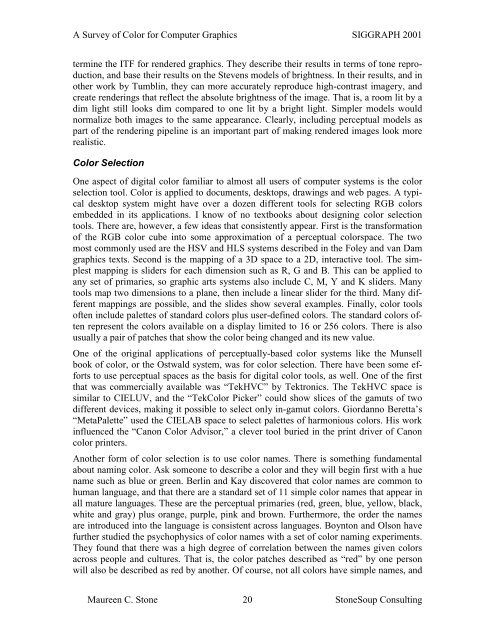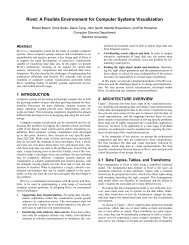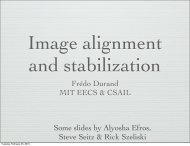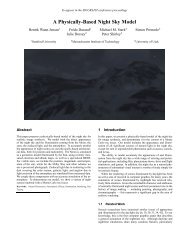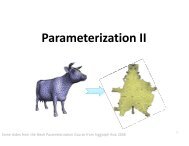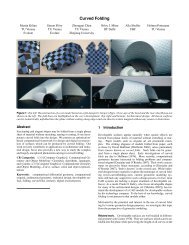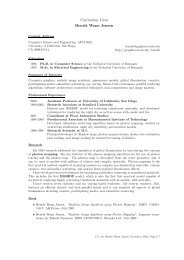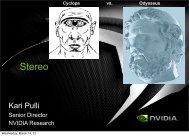A Survey of Color for Computer Graphics
A Survey of Color for Computer Graphics
A Survey of Color for Computer Graphics
Create successful ePaper yourself
Turn your PDF publications into a flip-book with our unique Google optimized e-Paper software.
A <strong>Survey</strong> <strong>of</strong> <strong>Color</strong> <strong>for</strong> <strong>Computer</strong> <strong>Graphics</strong> SIGGRAPH 2001<br />
termine the ITF <strong>for</strong> rendered graphics. They describe their results in terms <strong>of</strong> tone reproduction,<br />
and base their results on the Stevens models <strong>of</strong> brightness. In their results, and in<br />
other work by Tumblin, they can more accurately reproduce high-contrast imagery, and<br />
create renderings that reflect the absolute brightness <strong>of</strong> the image. That is, a room lit by a<br />
dim light still looks dim compared to one lit by a bright light. Simpler models would<br />
normalize both images to the same appearance. Clearly, including perceptual models as<br />
part <strong>of</strong> the rendering pipeline is an important part <strong>of</strong> making rendered images look more<br />
realistic.<br />
<strong>Color</strong> Selection<br />
One aspect <strong>of</strong> digital color familiar to almost all users <strong>of</strong> computer systems is the color<br />
selection tool. <strong>Color</strong> is applied to documents, desktops, drawings and web pages. A typical<br />
desktop system might have over a dozen different tools <strong>for</strong> selecting RGB colors<br />
embedded in its applications. I know <strong>of</strong> no textbooks about designing color selection<br />
tools. There are, however, a few ideas that consistently appear. First is the trans<strong>for</strong>mation<br />
<strong>of</strong> the RGB color cube into some approximation <strong>of</strong> a perceptual colorspace. The two<br />
most commonly used are the HSV and HLS systems described in the Foley and van Dam<br />
graphics texts. Second is the mapping <strong>of</strong> a 3D space to a 2D, interactive tool. The simplest<br />
mapping is sliders <strong>for</strong> each dimension such as R, G and B. This can be applied to<br />
any set <strong>of</strong> primaries, so graphic arts systems also include C, M, Y and K sliders. Many<br />
tools map two dimensions to a plane, then include a linear slider <strong>for</strong> the third. Many different<br />
mappings are possible, and the slides show several examples. Finally, color tools<br />
<strong>of</strong>ten include palettes <strong>of</strong> standard colors plus user-defined colors. The standard colors <strong>of</strong>ten<br />
represent the colors available on a display limited to 16 or 256 colors. There is also<br />
usually a pair <strong>of</strong> patches that show the color being changed and its new value.<br />
One <strong>of</strong> the original applications <strong>of</strong> perceptually-based color systems like the Munsell<br />
book <strong>of</strong> color, or the Ostwald system, was <strong>for</strong> color selection. There have been some ef<strong>for</strong>ts<br />
to use perceptual spaces as the basis <strong>for</strong> digital color tools, as well. One <strong>of</strong> the first<br />
that was commercially available was “TekHVC” by Tektronics. The TekHVC space is<br />
similar to CIELUV, and the “Tek<strong>Color</strong> Picker” could show slices <strong>of</strong> the gamuts <strong>of</strong> two<br />
different devices, making it possible to select only in-gamut colors. Giordanno Beretta’s<br />
“MetaPalette” used the CIELAB space to select palettes <strong>of</strong> harmonious colors. His work<br />
influenced the “Canon <strong>Color</strong> Advisor,” a clever tool buried in the print driver <strong>of</strong> Canon<br />
color printers.<br />
Another <strong>for</strong>m <strong>of</strong> color selection is to use color names. There is something fundamental<br />
about naming color. Ask someone to describe a color and they will begin first with a hue<br />
name such as blue or green. Berlin and Kay discovered that color names are common to<br />
human language, and that there are a standard set <strong>of</strong> 11 simple color names that appear in<br />
all mature languages. These are the perceptual primaries (red, green, blue, yellow, black,<br />
white and gray) plus orange, purple, pink and brown. Furthermore, the order the names<br />
are introduced into the language is consistent across languages. Boynton and Olson have<br />
further studied the psychophysics <strong>of</strong> color names with a set <strong>of</strong> color naming experiments.<br />
They found that there was a high degree <strong>of</strong> correlation between the names given colors<br />
across people and cultures. That is, the color patches described as “red” by one person<br />
will also be described as red by another. Of course, not all colors have simple names, and<br />
Maureen C. Stone 20<br />
StoneSoup Consulting


